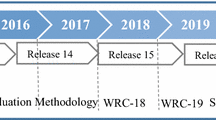Abstract
Index modulation (IM) is one of the emerging techniques for enabling beyond 5G (B5G) wireless communications. It has the potential to meet the stringent energy efficiency (EE) and spectral efficiency (SE) requirements of B5G systems with better error rate performance over the conventional techniques. IM relaxes the need for activating all the resources at the transmitter to transmit the information, thereby allowing low-complexity transmitter architecture designs. The key idea behind IM is to encode the information in the indices of the available resources at the transmitter such as antenna, sub-carriers in orthogonal frequency division multiplexing, time-slots, and radio frequency (RF) mirrors. Massive-MIMO is another such promising technique which provides unprecedented growth in both EE and SE for B5G wireless systems. Spatial multiplexed massive-MIMO is shown to achieve the unbelievable capacity gains over the conventional MIMO systems. However, achieving such gains requires dedicated signal processing resources for each antenna which increase the cost, area, and power-requirement at the transmitter. Interestingly, through IM in massive-MIMO, exceptionally high EE and SE can be achieved with minimal use of the available resources. Recently, multi-dimensional IM (MIM), wherein multiple resources are indexed simultaneously during transmission to enhance the SE further, has attracted researchers and experts from both academia and industry. In this chapter, we discuss different IM and MIM techniques, their representations, and advantages in B5G communications. In particular, we discuss spatial modulation, generalized spatial modulation, media-based modulation, and their possible combinations as MIM in detail. We also shed the light on the maximum-likelihood detection of information symbols in such systems.
Access this chapter
Tax calculation will be finalised at checkout
Purchases are for personal use only
Similar content being viewed by others
References
Andrews JG et al (2014) What will 5G be? IEEE J Sel Areas Commun 32:1065–1082
Basar E et al (2013) Orthogonal frequency division multiplexing with index modulation. IEEE Trans Sig Process 61(22):5536–5549
Basar E (2015) Multiple-input multiple-output OFDM with index modulation. IEEE Sig Process Lett 22(12):2259–2263
Basar E (2016) Index modulation techniques for 5G wireless networks. IEEE Commun Mag 54(7):168–175
Boccardi F et al (2014) Five disruptive technology directions for 5G. IEEE Commun Mag 52(2):74–80
Dai L et al (2018) A survey of non-orthogonal multiple access for 5G. IEEE Commun Surv Tutor 20(3):2294–2323
Di Renzo M, Haas H, Grant PM (2011) Spatial modulation for multiple antenna wireless systems: a survey. IEEE Commun Mag 49(12):182–191
Ding Z et al (2017) A survey on non-orthogonal multiple access for 5G networks: research challenges and future trends. IEEE J Sel Areas Commun 35(10):2181–2195
Gao Z, Dai L, Qi C, Yuen C, Wang Z (2017) Near-optimal signal detector based on structured compressive sensing for massive SM-MIMO. IEEE Trans Veh Technol 66(2):1860–1865
Jeganathan J, Ghrayeb A, Szczecinski L, Ceron A (2009) Space shift keying modulation for MIMO channels. IEEE Trans Wirel Commun 8(7):3692–3703
Jeganathan J, Ghrayeb A, Szczecinski L (2008) Generalized space shift keying modulation for MIMO channels. In: Proceedings of the IEEE 19th international symposium on personal, indoor and mobile radio communications, PIMRC, Cannes, France, pp 1–5
Khandani AK (2013) Media-based modulation: a new approach to wireless transmission. In: Proceedings of IEEE ISIT’, pp 3050–3054
Khandani AK (2014) Media-based modulation: converting static Rayleigh fading to AWGN. In: Proceedings of IEEE ISIT’ 2014, pp 1549–1553
Lu L, Li GY, Swindlehurst AL, Ashikhmin A, Zhang R (2014) An overview of massive MIMO: benefits and challenges. IEEE J Sel Top Sig Process 8(5):742–758
Mesleh RY et al (2008) Spatial modulation. IEEE Trans Veh Technol 57(4):2228–2241
Narasimhan TL, Raviteja P, Chockalingam A (2015) Generalized spatial modulation in large-scale multiuser MIMO systems. IEEE Trans Wirel Commun 14(7):3764–3779
Naresh Y, Chockalingam A (2017) On media-based modulation using RF mirrors. IEEE Trans Veh Technol 66(6):4967–4983
Ozturk E et al (2016) Generalized frequency division multiplexing with index modulation. In: Proceedings of IEEE Globecom workshops (GC Wkshps), Washington, DC, USA, pp 1–6
Rusek F et al (2013) Scaling up MIMO: opportunities and challenges with very large arrays. IEEE Signal Process Mag 30(1):40–60
Shamasundar B et al (2017) Multidimensional index modulation in wireless communications. IEEE Access 6:589–604
Wen M, Cheng X, Yang L (2017) Index modulation for 5G wireless communications (wireless networks series). Springer, Berlin, Germany
Yang S, Hanzo L (2015) Fifty years of MIMO detection: the road to large-scale MIMOs. IEEE Commun Surveys Tuts 17(4):1941–1988
Younis A, Seramovski N, Mesleh R, Haas H (2010) Generalised spatial modulation. In: Proceedings conference record of the forty fourth Asilomar conference on signals, systems and computers, Pacific Grove, CA, USA, pp 1498–1502
Acknowledgements
The authors would like to thank Start-up research grant, Science and Engineering Research Board (SERB) (File no. SRG/2019/000654) of Department of Science and Technology (DST), Government of India for supporting the research work. Authors would also like to thank Visvesvaraya PhD scheme of Ministry of Electronics and Information Technology, Government of India for their support.
Author information
Authors and Affiliations
Corresponding author
Editor information
Editors and Affiliations
Rights and permissions
Copyright information
© 2021 Springer Nature Singapore Pte Ltd.
About this chapter
Cite this chapter
Mandloi, M., Datta, A., Bhatia, V. (2021). Index Modulation Techniques for 5G and Beyond Wireless Systems. In: Mandloi, M., Gurjar, D., Pattanayak, P., Nguyen, H. (eds) 5G and Beyond Wireless Systems. Springer Series in Wireless Technology. Springer, Singapore. https://doi.org/10.1007/978-981-15-6390-4_4
Download citation
DOI: https://doi.org/10.1007/978-981-15-6390-4_4
Published:
Publisher Name: Springer, Singapore
Print ISBN: 978-981-15-6389-8
Online ISBN: 978-981-15-6390-4
eBook Packages: EngineeringEngineering (R0)




